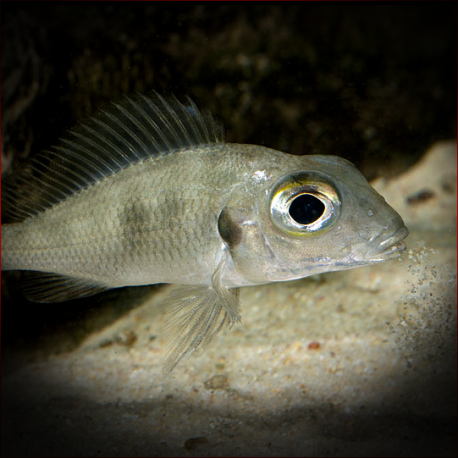More info
Datasheet
| Minimum Tank Size | 240 litres / 63.40 US gallons |
| Maximum Size | 13.5cm / 5.31inches |
| Temperature | 24°C / 75.20°F - 27°C / 80.60°F |
| Hardness | 10-30ºdH |
| pH | 7.8-9.5 |
General Description
The Callochromis Macrops, commonly known as the Big-Eyed Mouthbrooder, is a species of cichlid endemic to Lake Tanganyika. It belongs to the family Cichlidae and Pseudocrenilabrinae subfamily. This species can grow up to a maximum size of 13.5cm and requires a minimum tank size of 240 liters. Featuring various geographical color forms, it is important not to house different color forms together to prevent hybridization.
Aquarium Setup
For the Callochromis Macrops, a predominantly open sandy environment is crucial since it is a sand-sifting species. It is advisable to have a deep layer of sand (2-3") to facilitate natural behaviors. The tank should be minimally cluttered with rocky formations to allow males to construct bowers. Providing some rock piles and clumps of plants for female refuges is recommended, with Vallisneria and Ceratophyllum being suitable plant options (see table for water conditions).
Behaviour
Although found in large groups in the wild, in captivity, Callochromis Macrops tends to exhibit belligerent behavior towards conspecifics. Males may display high levels of aggression towards each other, especially in confined spaces. It is advisable to keep multiple females per male to disperse aggression and maintain a more harmonious tank environment.
Feeding and Diet
The species is a sand sifter, similar to South American "eartheaters," feeding on invertebrates and items hidden in the substrate. It primarily feeds on live and frozen foods, with substrates being the primary food source. Ensuring that enough food reaches the tank's bottom is essential for their nutrition.
Reproduction & Dimorphism
Callochromis Macrops is a maternal mouthbrooder, with females carrying a brood of 25-60 eggs for up to 3 weeks before releasing free-swimming fry. Males exhibit striking colors and grow larger than females, aiding in easy sexual dimorphism. Spawning behavior involves male nest building and colorful displays, with males enticing females to breed.
Habitat and Distribution
In its natural habitat, Callochromis Macrops inhabits open areas with sandy bottoms near rocks for cover, primarily in the southern part of Lake Tanganyika. It prefers shallow, murky habitats rich in suspended sediment, often among aquatic plants like Vallisneria spiralis and Ceratophyllum demersum.
For more detailed information, refer to the provided table for specific water conditions required for maintaining Callochromis Macrops successfully.

